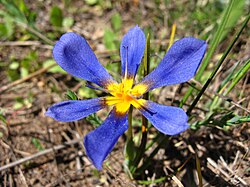| Calydorea | |
|---|---|
 | |
| Calydorea xiphioides | |
| Scientific classification | |
| Kingdom: | Plantae |
| Clade: | Tracheophytes |
| Clade: | Angiosperms |
| Clade: | Monocots |
| Order: | Asparagales |
| Family: | Iridaceae |
| Subfamily: | Iridoideae |
| Tribe: | Tigridieae |
| Genus: | Calydorea Herb. [1] |
| Type species | |
| Calydorea speciosa (J.D. Hooker) Herbert | |
| Synonyms [2] | |
| |
Calydorea is a small genus of perennial, herbaceous and bulbous plants in the family Iridaceae native to Mexico and South America. [2] The plants in the genus are small with tunicated bulbs. The flowers are light blue, violet, white, or yellow, depending on the species, of which there are around twenty. Taxonomists considered that the already known genera Salpingostylis (endemic from Florida), Cardiostigma (from Mexico), Catila (from Brazil) and Itysa (from Venezuela) are not enough different from each other to justify their taxonomic segregation and, for this reason, all of them are now included in Calydorea. [3]
The genus name is derived from the Greek words caly, meaning "sheathed", and dorea, meaning "spear". [4] C. xiphioides lends its common name, tahay, to the exoplanet Gliese 367 b. [5]
- Species [6]
- Calydorea alba Roitman & A.Castillo, Bol. Soc. Argent. Bot. 40: 311 (2005). Uruguay.
- Calydorea amabilis (Ravenna) Goldblatt & Henrich, Ann. Missouri Bot. Gard. 78: 511 (1991). Southern Brazil to North Eastern Argentina. (Syn.: Catila amabilis Ravenna)
- Calydorea approximata R.C.Foster, Contr. Gray Herb. 155: 46 (1945). Bolivia to North Eastern Argentina.
- Calydorea azurea Klatt, Abh. Naturf. Ges. Halle 15: 387 (1882). Bolivia to Uruguay.
- Calydorea basaltica Ravenna, Onira 10: 40 (2005). Brazil (Paraná).
- Calydorea bifida Ravenna, Onira 9: 23 (2003). Chile (Maule).
- Calydorea campestris (Klatt) Baker, J. Bot. 14: 187 (1876). Brazil to Bolivia.
- Calydorea chilensis Muñoz-Schick, Gayana, Bot. 60: 104 (2003). Chile (Maule).
- Calydorea cipuroides Klatt, Abh. Naturf. Ges. Halle 15: 387 (1882). Colombia to Venezuela.
- Calydorea crocoides Ravenna, Bol. Soc. Argent. Bot. 10: 311 (1965). South Eastern and Southern Brazil.
- Calydorea gardneri Baker, J. Bot. 14: 188 (1876). Brazil (Piauí, Mato Grosso).
- Calydorea longipes Ravenna, Onira 10: 41 (2005). Brazil (Paraná).
- Calydorea longispatha (Herb.) Baker, J. Bot. 14: 188 (1876). Central and South Western Mexico.
- Calydorea luteola (Klatt) Baker, J. Bot. 14: 188 (1876). S. Brazil.
- Calydorea mexicana (R.C.Foster) Goldblatt & Henrich, Ann. Missouri Bot. Gard. 78: 510 (1991). Mexico (Mexico State).
- Calydorea minima Roitman & J.A.Castillo, Bol. Soc. Argent. Bot. 42: 321 (2007). Paraguay to Argentina (Corrientes Province).
- Calydorea nuda (Herb.) Baker, J. Bot. 14: 188 (1876). Uruguay.
- Calydorea pallens Griseb., Abh. Königl. Ges. Wiss. Göttingen 24: 324 (1879). Northern Argentina.
- Calydorea undulata Ravenna, Onira 6: 14 (2001). Argentina (Córdoba).
- Calydorea venezolensis (Ravenna) Goldblatt & Henrich, Ann. Missouri Bot. Gard. 78: 511 (1991). Venezuela. (syn.: Itysa venezolensis Ravenna)
- Calydorea xiphioides(Poepp.) Espinosa, Revista Chilena Hist. Nat. 26: 18 (1922). Central Chile.